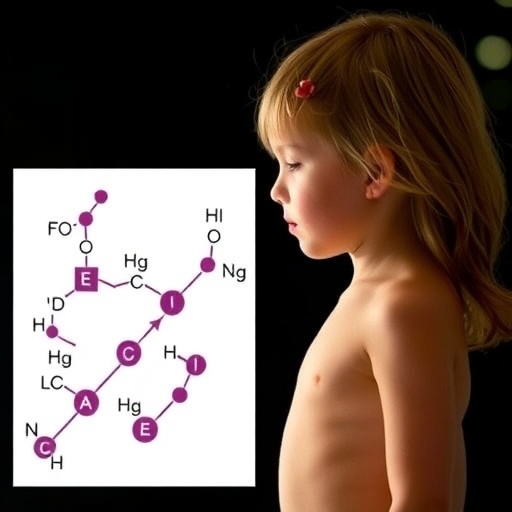In a groundbreaking development poised to reshape pediatric endocrinology, researchers have unveiled compelling evidence that serum bile acid profiling holds significant diagnostic promise for girls suffering from central precocious puberty (CPP). This nuanced biochemical approach could herald a new era of early and more precise diagnostics for a condition that demands urgent clinical attention due to its profound implications on growth and development.
Central precocious puberty, characterized by the premature activation of the hypothalamic-pituitary-gonadal axis, results in the onset of secondary sexual characteristics well before the typical age. Traditionally, diagnosis has leaned on clinical evaluation, hormone assays, and imaging techniques, each encumbered by limitations ranging from invasiveness to diagnostic ambiguity. This innovative study introduces serum bile acids—a class of biomolecules long recognized for their role in lipid digestion and metabolic regulation—as potentially invaluable biomarkers in this diagnostic conundrum.
The intricate study conducted by Wang, Liu, Liang, and colleagues meticulously quantified serum bile acid profiles in a cohort of girls diagnosed with CPP alongside healthy controls. Utilizing advanced liquid chromatography-mass spectrometry (LC-MS), the researchers teased apart the bile acid composition, revealing distinct alterations linked explicitly to the early activation of pubertal pathways. The lipidomic signatures discovered offer a window into hitherto poorly understood metabolic shifts accompanying CPP, suggesting that bile acids are more than mere digestive agents; they might be silent heralds of neuroendocrine change.
.adsslot_axgfN4uJK8{ width:728px !important; height:90px !important; }
@media (max-width:1199px) { .adsslot_axgfN4uJK8{ width:468px !important; height:60px !important; } }
@media (max-width:767px) { .adsslot_axgfN4uJK8{ width:320px !important; height:50px !important; } }
ADVERTISEMENT
These findings pivot on the biological premise that bile acids engage in complex signaling beyond the digestive tract, interacting with key nuclear receptors such as FXR (Farnesoid X receptor) and TGR5, both implicated in energy metabolism and inflammatory responses. Given the interconnected nature of metabolic pathways and neurodevelopmental timing, perturbations in bile acid metabolism uncovered in CPP patients could reflect or even drive the precocious activation of the hypothalamic-pituitary-gonadal axis. This theory, while requiring further mechanistic exploration, provides a fertile ground for understanding puberty’s biochemical undercurrents.
Beyond mechanistic intrigue, the clinical ramifications of this study are profound. Current diagnostic protocols for CPP often require repeated hormone stimulation tests, which are cumbersome and distressing to patients. By contrast, serum bile acid profiling promises a non-invasive, rapid, and sensitive diagnostic adjunct, potentially streamlining clinical workflows and enabling earlier intervention. Early detection is critical as untreated CPP can result in compromised adult height, psychosocial challenges, and a constellation of metabolic disturbances.
Moreover, the study’s data openness and rigorous methodology underscore the reproducibility and robustness of serum bile acid profiling as a diagnostic tool. The use of state-of-the-art metabolomic platforms combined with stringent statistical modeling allowed for the reliable discrimination between CPP and non-CPP subjects. This high level of specificity and sensitivity is crucial for clinical adoption, particularly in pediatric settings where diagnostic precision directly impacts therapeutic decisions.
In an era where personalized medicine reigns supreme, bile acid profiling may also offer avenues for patient stratification and monitoring treatment efficacy. Different bile acid species have diverse physiological roles, and shifts in their serum concentrations could reflect not only disease presence but also progression or response to interventions such as GnRH analog therapy. Thus, this profiling may evolve from a mere diagnostic marker to a dynamic clinical tool guiding individualized care.
The interdisciplinary nature of this research underscores the synthesis of pediatrics, endocrinology, and metabolomics. It highlights how broadening our biological lenses beyond classical hormone assays can yield untapped biomarkers with superior diagnostic power. As metabolic phenotyping technologies become increasingly accessible, integrating such metabolomic data into routine clinical practice could transform approaches to pediatric disorders like CPP.
Furthermore, this study sparks questions regarding bile acids’ larger role in neuroendocrine regulation and puberty initiation. Could manipulation of bile acid pathways offer therapeutic potential? Do environmental or dietary factors influencing bile acid pools modulate the timing of puberty? These provocative inquiries open vistas for future research, bridging metabolism, neurobiology, and developmental endocrinology.
The societal impact of this research is equally salient. With increasing rates of CPP reported globally—potentially linked to rising obesity, environmental endocrine disruptors, and altered lifestyles—improved diagnostic modalities are necessary to address a growing public health concern. Serum bile acid profiling could serve as an accessible screening tool, facilitating community-level interventions and informed healthcare planning.
Critically, the safety profile of serum bile acid measurement stands out. Unlike dynamic hormone testing, which often necessitates intravenous access and multiple blood draws, bile acid assays require minimal sample volume and pose no additional risk. This patient-friendly approach aligns with pediatric care principles emphasizing minimal invasiveness and maximal diagnostic yield.
The study, published in World Journal of Pediatrics in 2025, exemplifies the synergy between cutting-edge analytical chemistry techniques and clinical endocrinology. It beckons further large-scale validation across diverse populations to cement bile acid profiles’ place in diagnostic algorithms. Addressing variability related to diet, microbiome composition, and genetic factors will be pivotal to standardizing this approach.
From a broader vantage point, the elucidation of bile acid perturbations in CPP challenges traditional frameworks that viewed puberty solely through hormonal and neurological prisms. It underscores metabolism’s emerging centrality in developmental biology, inviting a paradigm shift toward integrative multi-omics diagnostic strategies.
As the medical community grapples with the complex etiology and management of puberty disorders, the integration of metabolic biomarkers such as serum bile acids heralds a transformative phase. This study not only advances diagnostic science but also exemplifies the potential of metabolomics to unveil hidden signatures of human development and disease.
In conclusion, serum bile acid profiling emerges as an exciting frontier in diagnosing central precocious puberty in girls, offering a novel, sensitive, and non-invasive biomarker reflecting underlying neuroendocrine and metabolic interplay. Continued interdisciplinary research and clinical validation could soon translate these findings into impactful bedside applications, improving outcomes for affected children worldwide.
Subject of Research: Potential diagnostic value of serum bile acid profiling in girls with central precocious puberty.
Article Title: Potential diagnostic value of serum bile acid profiling in girls with central precocious puberty.
Article References:
Wang, S., Liu, A.N., Liang, XY. et al. Potential diagnostic value of serum bile acid profiling in girls with central precocious puberty. World J Pediatr (2025). https://doi.org/10.1007/s12519-025-00937-z
Image Credits: AI Generated
DOI: https://doi.org/10.1007/s12519-025-00937-z
Tags: biochemical profiling in pediatricsbiomarkers for central precocious pubertyclinical implications of bile acid researchearly diagnosis of puberty disordershormonal activation and growth developmenthormonal disorders in girlsimplications of central precocious pubertyinnovative diagnostic techniques for CPPlipid metabolism and pubertyliquid chromatography-mass spectrometry in diagnosticspediatric endocrinology advancementsserum bile acids and precocious puberty





